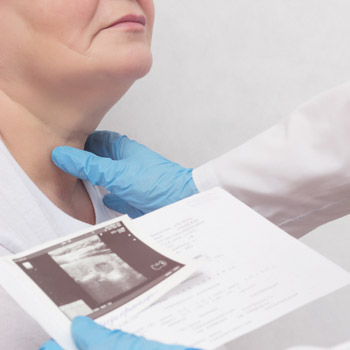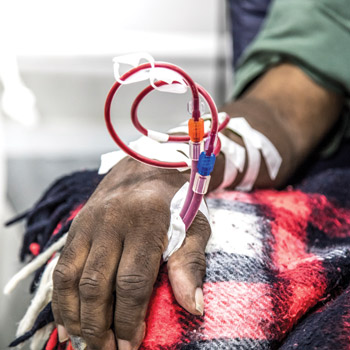Subclinical hypothyroidism prompts personalized decisions
For diagnosing and managing subclinical hypothyroidism, clinical context such as age and symptoms matter, even in the face of an incomplete understanding of the condition.
Subclinical hypothyroidism is diagnosed biochemically when a patient's serum thyroid-stimulating hormone (TSH) level reaches 4.5 mU/L or higher and the thyroxine (T4) level is normal. But decisions about what comes next—whether to watch and wait, or to treat—remain controversial, with few randomized controlled trials to guide the debate.
Even the decision about whether to screen asymptomatic individuals is colored by the lack of consensus about how they will be managed later.

“The clinical context really matters,” said David S. Cooper, MD, MACP, a professor of medicine and director of the thyroid clinic at Johns Hopkins University School of Medicine in Baltimore, who said he considers age, symptoms, and other factors when deciding whether to treat.
ACP Member Douglas Bauer, MD, a general internist and a professor of medicine, epidemiology, and biostatistics at the University of California, San Francisco, said he believes the differences in approach often come down to a subspecialist versus specialist view of managing the condition, with endocrinologists often favoring treatment at a lower TSH threshold and internists more frequently choosing to watch and wait.
“It's an incomplete database, so it's pretty clear we don't know what the ‘right’ thing to do is,” Dr. Bauer said.
Screening and diagnosis
The range of guidelines surrounding asymptomatic screening appears to reflect some of those differences.
In 2015, the U.S. Preventive Services Task Force concluded that the available evidence was insufficient to assess the balance of benefits and harms of screening for thyroid dysfunction in nonpregnant, asymptomatic adults.
However, other organizations have recommended thyroid testing based on age or symptoms. For instance, the American Thyroid Association recommends screening of adults starting at age 35 years and continuing every five years. The American Association of Clinical Endocrinology suggests routine screening of older adults, especially women, but does not specify at what age screening should begin. The American Academy of Family Physicians endorses routine screening after age 60 years.
“[Subclinical hypothyroidism] fulfills most of the criteria for a screenable disease,” Dr. Bauer said. “It's common, we have a good test so you can reliably identify individuals who have the abnormality, and treatments that correct the test abnormality exist. But the U.S. Preventive Services Task Force does not recommend asymptomatic screening, and I generally agree with the idea that if it is not clear that you are able to improve clinical outcomes, you shouldn't screen for it.”
Subclinical hypothyroidism can be caused by a variety of conditions, including chronic lymphocytic thyroiditis, also known as Hashimoto thyroiditis; inadequate levothyroxine replacement therapy for patients with overt hypothyroidism; or, more rarely, infiltrative disorders, such as amyloidosis and Riedel thyroiditis. It can occur after thyroid lobectomy, antithyroid drug or radioiodine therapy for hyperthyroidism, or external beam radiotherapy of the head and neck, or after an episode of subacute thyroiditis. Drugs such as lithium carbonate, iodine-containing compounds, interferon-alfa, and tyrosine kinase inhibitors can also produce subclinical hypothyroidism.
TSH may also be elevated but not indicate thyroid dysfunction in elderly patients, in individuals with a body mass index above 40 kg/m2, and in patients with untreated adrenal insufficiency. And patients with heterophilic antibodies can have elevated thyroid levels without true thyroid dysfunction.
It can be difficult to decide whether to order thyroid blood testing based on reported symptoms, especially in the current environment, said Anne R. Cappola, MD, ScM, professor of medicine in the division of endocrinology, diabetes, and metabolism at the Perelman School of Medicine at the University of Pennsylvania in Philadelphia.
“The problem is when you have symptoms like fatigue and weight gain and difficulty concentrating, which probably during a COVID pandemic most of the population has,” Dr. Cappola said. “Then that becomes a lot of TSH ordering.”
She encourages physicians to rely on their clinical suspicion and take a thorough history, asking about the patient's diet, exercise, sleep, and mental health. “It's not a thyroid problem if you're tired because you don't sleep at night,” she said.
Dr. Cappola said she is more likely to favor testing in cases where there are symptoms plus a family history, a known history of antithyroid antibodies, or a goiter, or if a woman is planning a pregnancy.
Once the decision is made to test and the results show the combination of elevated TSH and a normal T4, there is consensus that a repeat test is needed within a few months. Treatment should not be initiated unless the elevated levels are persistent, since it is common for the elevation to spontaneously resolve. “You don't want to treat something that was going to go away on its own,” Dr. Cappola said.
Evidence surrounding treatment
The reasons to treat subclinical hypothyroidism include improvement in symptoms, prevention of overt hypothyroidism, and prevention of adverse cardiac events. These are balanced against the potential harm from treatment of reducing TSH levels to the point of causing iatrogenic subclinical or overt hyperthyroidism, according to review coauthored by Dr. Cappola and Cooper and published in July 2019 by JAMA. Overtreatment can lead to atrial fibrillation, osteoporosis, and fractures in older patients, particularly postmenopausal women.
But perhaps a more significant consideration is the limited evidence that treatment with thyroid hormone replacement is effective.
The largest randomized controlled trial to date was the Thyroid Hormone Replacement for Untreated Older Adults with Subclinical Hypothyroidism (TRUST) trial, which was published in June 2017 in the New England Journal of Medicine. It randomized 737 adults ages 65 years and older to levothyroxine versus placebo. The trial found no effect for levothyroxine on either hypothyroid symptoms or fatigue scores after 12 months of therapy. There was also no effect reported on secondary outcomes, such as quality of life, cognitive function, carotid intima-media thickness (CIMT), or carotid plaque thickness.
These findings were bolstered by a later systematic review and meta-analysis that included the TRUST trial and 20 other studies. The meta-analysis, published in October 2018 by JAMA, found no difference in symptoms for subclinical hypothyroidism patients treated with levothyroxine versus placebo. There were also no differences seen in terms of depression, cognitive function testing, fatigue, muscle strength, BMI, and systolic blood pressure. And a secondary analysis of the TRUST trial, published in the June 2, 2020, Annals of Internal Medicine, found that even participants with more severe hypothyroid symptoms and fatigue did not appear to benefit from thyroid replacement therapy, noted Dr. Bauer, who was a coauthor on both TRUST papers.
But there is conflicting evidence. A meta-analysis of 12 randomized controlled trials, conducted before publication of the TRUST trial and published in July 2017 by the Journal of Atherosclerosis and Thrombosis, showed a statistically significant improvement in two surrogate markers for cardiovascular disease, CIMT and lipid profile, with levothyroxine.
So far, no randomized controlled trial has had the statistical power to provide a definitive answer on the impact of treatment on dementia or fracture risk. There are some retrospective data indicating that treatment resulted in lower all-cause mortality, but only in patients younger than age 70 years.
Overall, the 2019 JAMA review noted that observational studies suggest no evidence of increased risk of cardiovascular events and a low risk of progression for patients on the lower end of grade 1 subclinical hypothyroidism (TSH levels of 4.5 to 6.9 mU/L), but a higher risk of progression and some risk of cardiovascular events in those with a TSH level of 7.0 to 9.9 mU/L and the highest risk with a TSH level of 10 mU/L or higher.
Treating and monitoring
Guidelines also vary on the ideal threshold for treatment. In 2012, the American Thyroid Association recommended treatment when the TSH level is above 10 mU/L and consideration of treatment in those with increased cardiovascular risk when the TSH level is between 4.5 and 10 mU/L in patients with subclinical hypothyroidism. In 2014, the group additionally recommended that for individuals with subclinical hypothyroidism and known cardiovascular disease, levothyroxine treatment should be started at a low dose and increased as needed.
Most recently, in 2019, an international expert panel of general internists and endocrinologists recommended against treatment of subclinical hypothyroidism in most cases, unless the TSH level was higher than 20 mU/L. This guidance, published in May 2019 by the BMJ, is the only one to set such a high treatment threshold.
The 10 mU/L value is not based on strong randomized trial evidence, Dr. Bauer said. “Like many test thresholds in medicine, TSH values greater than 10 are a convenient cut point that make sense to people and are easy to remember. That's kind of how this notion of 10 as the optimal treatment threshold got ingrained in the medical literature.”
But it is also unlikely to be harmful, Dr. Bauer said. He advises waiting and watching for most patients with subclinical hypothyroidism who are not symptomatic because the TSH levels tend to fluctuate and do not progress. He does not favor the use of an empiric trial of thyroid replacement therapy for symptoms because there is a significant placebo effect.
“Most of the potential harms that we worry about with untreated subclinical hypothyroidism are more common in the elderly, such as heart failure and myocardial infarction. So, if you're not going to make somebody feel better by treating them and the diseases that you hope to prevent mostly afflict older people, then deciding not to treat younger individuals is reasonable,” Dr. Bauer said. “And I tend not to.”
Angela M. Leung, MD, MSc, associate professor of medicine at the UCLA David Geffen School of Medicine and an endocrinologist at UCLA and the VA Greater Los Angeles Healthcare System, said she has confidence starting treatment for patients with a TSH at or above 10 mU/L. She may treat at a lower threshold in nonelderly patients if they are symptomatic, have cardiovascular risk factors, or have thyroid autoantibody positivity. If women are considering pregnancy, or are pregnant or postpartum and breastfeeding, treatment would always be recommended, she said. In older patients, who may have a natural TSH level hovering between 6 and 8 mU/L, Dr. Leung only treats if it is persistently above 10 mU/L.
Christian E. Nasr, MD, FACP, an endocrinologist at the Cleveland Clinic, said it's important to use extra care when considering treatment for elderly patients, who face more risks from overtreatment and may not benefit. For a patient who is 70 years old with a mildly elevated TSH level, Dr. Nasr recommends continued monitoring. The evidence does not support starting treatment at a level below 7 mU/L in someone older than age 70 years, he said, and he would not treat an older patient who did not have symptoms. If the TSH level is greater than 10 mU/L, Dr. Nasr generally offers treatment to patients regardless of age because of the higher risk of progression to overt disease.
Dr. Cooper said he views a TSH level above 10 mU/L as a line in the sand for starting treatment but generally is less likely to treat someone as they get older. And despite the variation in guidelines and physicians' treatment approaches, Dr. Cooper said the decision often boils down to using clinical judgment based on an individual patient's risk and preferences.
“I think treatment has been oversold in terms of it being dangerous or expensive,” Dr. Cooper said. “Yes, it might be unnecessary; I can't prove to you that it helps people. But it's not really dangerous, at least in younger people. The fear that you're going to cause harm to the person, I think, may be overblown.”





